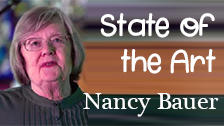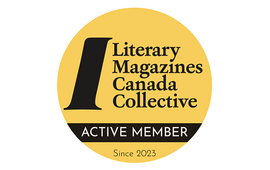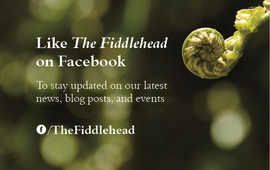
Nancy Bauer on John Leroux on Claude Roussel
Even though I thought I wasn’t interested in the subject of John Leroux’s July 11th noon talk at the Beaverbrook Art Gallery, I went anyway to support the project. I’m sure glad I did. As I have come to expect, Leroux delivered an illuminating talk, entitled “Claude Roussel's Monumental Models.” It was a revelation to me, demonstrating the importance of Roussel to the visual arts of New Brunswick. I said to myself several times that I wished every New Brunswicker could hear this.
Roussel’s sculptures are everywhere in the province — I was familiar with most of those Leroux showed, but even though I’ve seen them regularly, I haven’t immediately thought, “Roussel.” I realized how much his work dominates the landscape. His large bronze construction decorates the tower at the Fredericton airport. His grey limestone sculpture “The Two Beavers” plays in Officer’s Square. Three massive fiberglass blocks adorn Saint John’s city hall. A photograph of his stone “Monument of the Escuminac Disaster” (1969) is always brought out at anniversaries of that fishermen tragedy or following similar misfortunes. Many churches feature his Stations of the Cross. Among other materials, he uses metal, wood, concrete, stone, wire, fiberglass, welding, and epoxy. He was and still is an innovator.
Leroux presented these sculptures in the context of Roussel’s life — from his early twenties until now, having just turned 88. By the time he was in his early twenties, Roussel was already considered to be the best sculptor in the province. He became a curator at the Beaverbrook Art Gallery. He was admired by Lord Beaverbrook, and “The Two Beavers” was commissioned by the province to celebrate the great man’s 80th birthday in 1959. Leroux’s vast knowledge and joyful passion for the art and architecture of the province allowed him to frame Roussel’s work, not only in the context of the artist’s own life, but also of the province’s history. Leroux always straightens me out on the cultural past.
I’m increasingly aware that I’ve lived here during a blossoming of the arts not only in this province but in the whole of Canada. Because I’ve survived to the ripe old age of 84, I can appreciate this when it’s shown to me. I came to the province in 1965; Leroux pointed out that the 60’s and 70’s were a boom time here, not only in the arts but in the economy as a whole. I myself witnessed, in a few short years, the immense growth of the university; I used its inadequate library, and then gloried in its fine one built in 1967. Roussel participated in the founding of the Université de Moncton in 1963, establishing the Visual Arts Department which germinated Acadian art — Yvon Gallant, Luc Charette, Marie Hélène Allain, Paul Édouard Bourque, Herménégilde Chiasson, Francis Coutellier — the list goes on. In the 1980’s as a member of Gallery Connexion I began to meet these artists.
The gallery has acquired most of the maquettes of Roussel’s sculptures; I counted 21. The display of them in two glass cases is charming, like exquisite miniatures in a dollhouse.
My house, a modest bungalow built in 1966, is now an historic artifact — a “mid-century house.” I learned this when Leroux visited me and said enthusiastically as he crossed the threshold, “You have a mid-century house!” According to him, the fact that I hate the disruption of refurbishing makes the house even more an authentic antique with its original unpainted mahogany window and door trim. Realizing that I have witnessed what has become history is a recent understanding. I’m discovering that it is a reassuring way to confront aging.











Comments
State of the Art
State of the Art
Add new comment